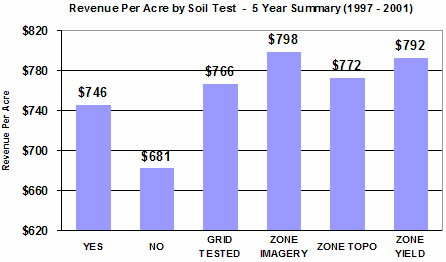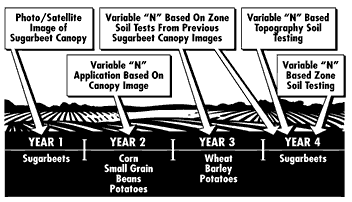427 - Variable Rate Fertilizer Impacts on Yield, Quality and Revenue Per Acre
Profitable sugarbeet production begins with a progressive research based nitrogen fertility management program. The new nitrogen fertilizer recommendations for sugarbeet in North Dakota and Minnesota are given below. Be sure and ask your soil sampler, soil testing lab and fertilizer dealer to use these recommendations.
| Soil Sample Depth | Total Soil Test Plus Added Fertilizer N Required |
|---|---|
| (Feet) | (lbs.) |
| 0-2 | 100 |
| 0-4 | 130 |
Using best management practices for soil fertility can increase revenue per acre by $30, $40 or $50/acre over conventional soil sampling and not using variable rate N fertilization. Data from Figure 1 clearly indicates the value of zone soil sampling and variable rate fertilization based on the 5 year (1997-2001) summary of grower practices data.

Steps to Achieving These Goals
- Manage the rotation
- Use zone soil sampling
- Use beet top N credits
- Follow new fertilizing recommendations
- Then variable rate apply nitrogen fertilizer

Use American Crystal Sugar Company Grower Practices data and past beet crop imagery to analyze your fertility program:
- Know where you stand versus piler, factory, and RRV crop quality.
- Determine strengths/weaknesses in your fertility management program.
- Develop a plan to get where you want to be.
- Put your agriculturist to work for you providing assistance.
An excellent place to start refining your fertility management program is taking historical beet canopy images from the last time 2003 beet fields were cropped to beets and develop zone maps to soil sample them this fall. Consultants and soil samplers working with agriculturists have found up to 40 lbs./acre and greater difference in available N in different zones of fields to be planted to beets in 2003. Consequences of not using variable rate nitrogen fertilization for 2003 beet fields when its justified are:
| Problem | Consequences |
|---|---|
| Under fertilization of part of field | Lost yield |
| Over fertilization of zones | Decreased quality Increased fertilization costs Environmental risk |
What is the Value of Fertility BMP’s
By increasing sugar and reducing SLM by a net of 0.5% the result is:
- 10 lbs. more sugar/ton.
- .9 million cwt. more sugar.
- $2.20 increase in beet payment/ton.
- On a 9 million ton crop that would equal a $20,000,000 contribution to American Crystal’ beet payment.
Plant Population Data Accuracy
The plant population data all shareholders will receive on field reports for the 2002 crop year should much better reflect your actual stand counts in fields. The quality lab stand counts will be adjusted by a correlation factor to closely relate them to your field observations. For example a field report lab count of 120 for 2001 would show a 170 count in 2002. To adjust past field reports divide the harvest population reported by .7048. Contact your agriculturist for further information if this is still unclear.
Bright Yellow Spots In Field?
Incidence and severity of rhizomania has increased greatly in the Red River Valley in 2002. If your not sure if those spots in fields are rhizomania contact your agriculturist for help. Proper disease identification is critical to 2003 variety selection.
Goal of Successful Sugarbeet Production
- Maximize net sucrose per ton and per acre while
- Maintaining maximum yields and
- Maximizing on-farm profit.
Idea Contest
Take time now to get photographs and other documentation of innovative ideas. Entry forms for the 2002 contest are available from your agriculturist.
Complete Your NDSU Survey
Please return your grower practices surveys to Dr. Alan Dexter ASAP. You can complete them very quickly and easily on-line in the shareholder info section.
